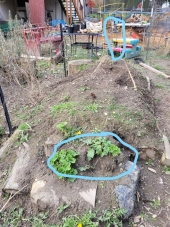




 1
1




Invasive plants are Earth's way of insisting we notice her medicines. Stephen Herrod Buhner
Everyone learns what works by learning what doesn't work. Stephen Herrod Buhner
 2
2




Mediterranean climate, hugel trenches, fabulous clay soil high in nutrients, self-watering containers with hugel layers, keyhole composting with low hugel raised beds, thick Back to Eden Wood chips mulch (distinguished from Bark chips), using as many native plants as possible....all drought tolerant.




Cristo Balete wrote:
C Murphy, for what it's worth, and from my experience in a rural place for the last 35 years, a 7 or 8 foot tall living fence would require clipping/trimming probably on a ladder. There's probably enough to do without that kind of job added to the list, and it will create some shade on the other side of it, not so great for vegetables.
Also, where I am, deer are the easiest to deter. It's the packrats, roof rats, and the rabbits, and sometimes even voles will climb and chew things off. Those critters chew everything, and packrats like to decorate, so they will chop stuff down and haul it off, doesn't matter if it's toxic to them or not.
So a living fence will be wide open on the bottom to little critters like that. Rabbits, packrats, roof rats, voles leave a 45 degree angle on the cut, and not deer, so you can tell who's been out there chewing. Foxes, bless their hearts, I just love them, but they will raid the fruit off of a fruit tree, breaking branches as they go, and need a solid barrier.
I have one acre fenced in, 200 feet on a side, 800 feet total, and this has been the most reliable for me for the last 30 years. There's 2 rows/layers of chicken wire spread horizontally. The one-inch hole chicken wire, 3 feet high is the lowest layer. The bottom bent outwards about 6 inches so the weeds can grow through it and hold it down. If anything is getting through there will be a trail through this six-inch edge that is obvious. Rabbits sometimes get under this edge when the weeds die, but it's rare. It can be held down with a slanted stake pounded into the ground.
The top layer is the two-inch-hole galvanized construction plaster wire (that looks like chicken wire,) three feet high, is the top row. (I have yet to have this construction stuff rust, but packrats can get through two-inch holes so I don't use it on the bottom.)
Upright metal T posts with shorter extensions take it up to 8 feet, with the plastic rope that ties hay bales strung across the top from pole to pole. The gap from the wire to the rope is not big enough for deer to risk it. People who feed their large animals hay will have bags and bags of this rope that they love to get rid of. It lasts for years. It also makes the chicken wire edge visible to birds, like quail, who in a panic 14 of them go over the fence and the last guy doesn't smack right into the chicken wire. This rope is also a godsend for tying things, strapping things down, it's great stuff, very sturdy. It's usually blue and white. Knot the ends of it so it doesn't unravel.
The chicken wire is easily wired onto the poles with a strand of about 14 gauge galvanized wire, 100 feet for less than $10. Then the two layers are "sewed" together, about every 7 or 8 holes, because the deer are smart enough to slip between the layers.
Every 6 or 7 years I might have to replace a section, it depends on the manufacturer that Home Depot gets it from. One whole side of mine from 2006 has never rusted. But it's easy to replace. It's a bit of an investment to start with, but you can go to bed at night not having to will things to be there in the morning.




Anne Miller wrote:The deer where I live are white tail deer.
These ddr do not eat my rosemary bush so I often use cutting to stick over my rose bush to keep the deer from eating that.
I have lots of prickly pears which they will eat the tunas though be aware that during had times the deer might eat some of the pads though I doubt that the deer would eat all the plants.
I don't know if agarita will grow where you live though that is another that they eat the berries and leave the bush.
I am sure others will chime in with their experiences.




Invasive plants are Earth's way of insisting we notice her medicines. Stephen Herrod Buhner
Everyone learns what works by learning what doesn't work. Stephen Herrod Buhner




Anne Miller wrote:I knew we are a very different climate though before mentioning rosemary and prickly pear, I did check to see if they grow there.
I like the idea of a polyculture-type hedge with tall hedges in the cent with a border of smaller shrubs.
The thicker the living hedge the more likely that deer will not jump the living hedge especially if the lower shrub will deter them like the rosemary and prickly pear.
https://www.centralcoastbiodiversity.org/bog-rosemary-bull-andromeda-polifolia.html
https://a100.gov.bc.ca/pub/eswp/speciesSummary.do;jsessionid=058e554485ed62ff2e7e9e6d79bac242a944bd38124adca7dc6f20371e18f74f.e3uMah8KbhmLe34Tb3aOa3uOaN90n6jAmljGr5XDqQLvpAe?id=18423
 4
4




Creating sustainable life, beauty & food (with lots of kids and fun)

|
I didn't say it. I'm just telling you what this tiny ad said.
The new gardening playing cards kickstarter is now live!
https://www.kickstarter.com/projects/paulwheaton/garden-cards
|







